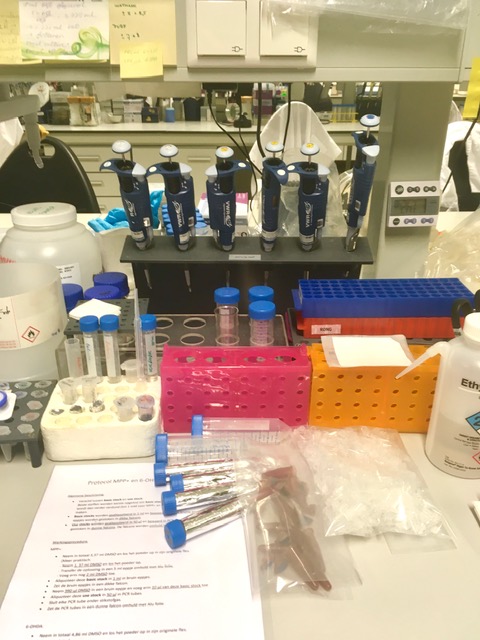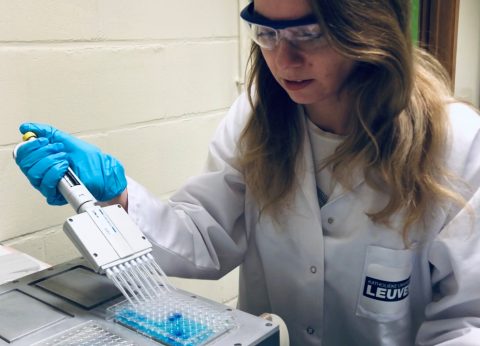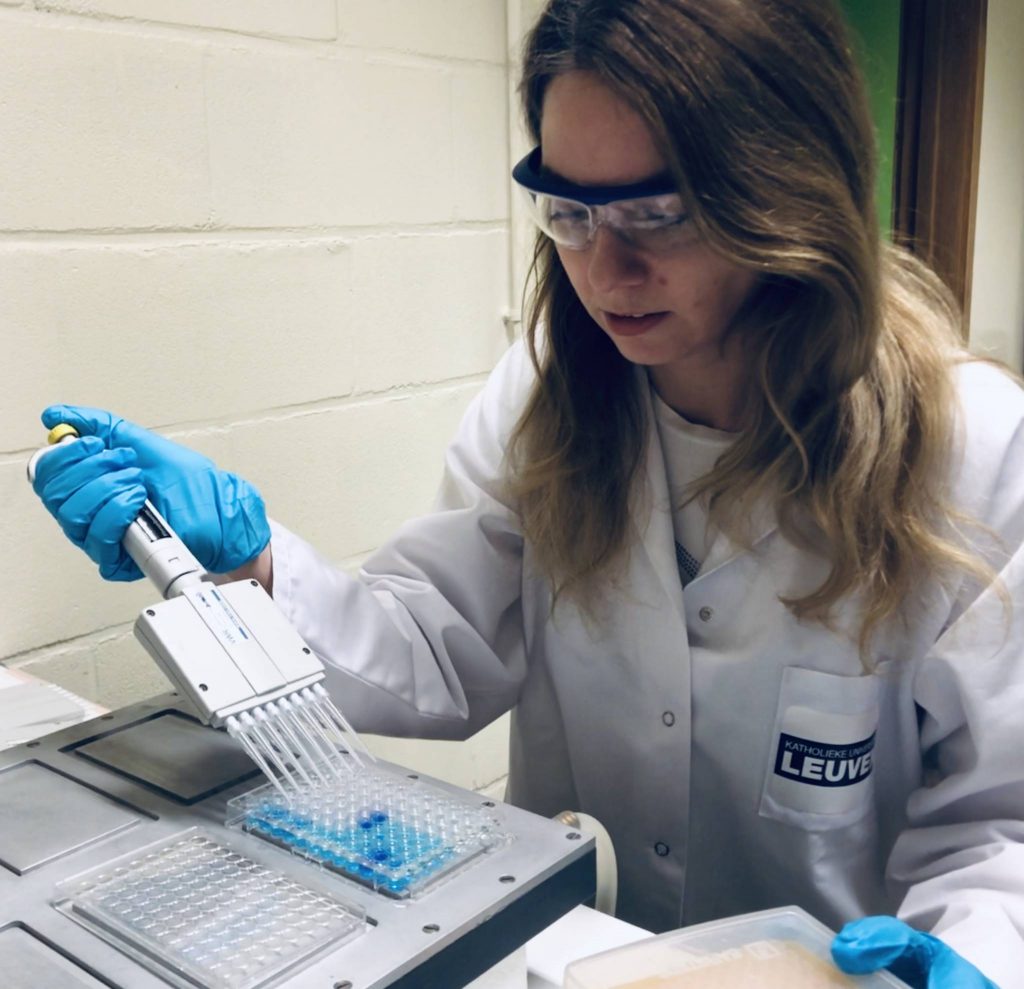Sarah van Veen remembers the moment her lab experiment went blue, as if it was yesterday!
It was September 2016 and she was two years into her biomedical science doctorate studying how a dysfunctional protein in brain cells contributed to the development of Parkinson’s Disease.
“I wasn’t really expecting to see blue that day,” she said, speaking to us the morning after her research results were published by prestigious scientific journal Nature.
“We had designed the experiment so that if we got a positive reaction, the sample would turn blue. But we were testing a protein that in previous experiments had never reacted to test compounds, so our expectations for positive results were low by that time. We were being thorough by testing a bunch of candidate substrates, and we were making sure that we could scratch them off the list. But the sample reacted to a particular compound. It went blue, the result that we were hoping to see. I’ll never forget the moment.” (Photo: Sarah van Veen)
What Sarah, a member of the KU Leuven’s laboratory of Cellular Transport Systems, had discovered was that the ATP13A2 protein transports cell-renewing and anti-aging polyamines in brain cells, or neurons. Therefore, when this ‘transporter protein’ malfunctions — as a result of a gene mutation often found in Parkinson’s patients – these vital polyamines can no longer travel in the cell as they should and the neuron’s internal ‘garbage disposal units’ (lysosomes) burst, causing the cell to die. The loss of these vital brain cells is what causes the debilitating symptoms associated with Parkinson’s Disease. Preventing their loss by ensuring the continued correct flow of polyamines through the ATP13A2 protein could therefore be key – be THE key – to avoiding, stopping or perhaps even reversing the effects of Parkinson’s Disease.
“It was a big deal finding out what ATP13A2 actually does – and getting it published in Nature has been a dream come true for me personally – but it’s just the first piece of the puzzle and was only possible because of all the research done by others, on which our research was able to build,” Sarah said. “Now others will take our research to the next level and see how they can use our insights to create an effective drug. There’s a long way still to go, but I’ll always feel very connected to this work.”
The role of basic research in drug development
 Indeed, the head of the laboratory where Sarah carried out her painstaking research, Prof. Peter Vangheluwe, estimated that getting to this stage has taken 10 years and said that more research is now needed to work out how to turn the ATP13A2 protein on and off. Small molecules will then be designed that control the functioning of this protein, which may be part of a future treatment for patients.
Indeed, the head of the laboratory where Sarah carried out her painstaking research, Prof. Peter Vangheluwe, estimated that getting to this stage has taken 10 years and said that more research is now needed to work out how to turn the ATP13A2 protein on and off. Small molecules will then be designed that control the functioning of this protein, which may be part of a future treatment for patients.
This hunt for an effective molecule will be carried out by his team together with KU Leuven’s Center for Drug Design and Discovery (CD3) and US-based Parkinson’s charity The Michael J. Fox Foundation (MJFF). The ultimate aim is to license any potential molecule candidates that are identified to a pharmaceutical company for further research and development, including expensive clinical trials. (Photo: Prof. Peter Vangheluwe)
“We have done the ‘basic’ research and now we’ll work with CD3 to bridge the divide between our discovery and the point at which pharmaceutical companies feel confident enough to step in,” he told Demoucelle Parkinson Charity co-founders Patrick and Anne-Marie during a visit to his laboratory just ahead of the Nature publication. “It will take several years to get to the point of having a validated treatment, but we are learning all the time and applying what we have learned to other research and getting faster.”
Vangheluwe said that it was vital to get financial support for basic research from the university and charities such as MJFF and the Demoucelle Parkinson Charity (which is supporting a ‘sister’ project on the transporter protein ATP10B) as without it the foundation stones of drug discovery would not be laid.
“Only 10 to 20% of basic research projects proposed actually get funded and these type of studies are very expensive, so getting seed funding for them is so helpful and we are very grateful,” he said during a presentation of his team and their work.
 The funding is used to pay researchers’ salaries, buy equipment, grow the necessary cells, hold important information-sharing meetings and attend conferences, Vangheluwe said. While finding a drug that can cure patients is clearly the ultimate aim, for scientists conducting basic research achieving milestone breakthroughs that are worthy of an article in ‘Nature’ are a welcome morale boost and an important way to spread know-how and speed up research across the globe.
The funding is used to pay researchers’ salaries, buy equipment, grow the necessary cells, hold important information-sharing meetings and attend conferences, Vangheluwe said. While finding a drug that can cure patients is clearly the ultimate aim, for scientists conducting basic research achieving milestone breakthroughs that are worthy of an article in ‘Nature’ are a welcome morale boost and an important way to spread know-how and speed up research across the globe.
Sister ‘transport protein’ project boosted
In fact, Sarah’s colleague (and life partner) Shaun Martin, a British senior postdoctoral scientist, who assisted her in the ATP13A2 project has already been able to apply learnings to his own investigations of the role of transporter protein ATP10B.
Both Shaun’s grandmothers had Parkinson’s Disease so for him “this research is both personal and professional,” he told Patrick & Anne-Marie, noting that it was thanks to grants from the Demoucelle Parkinson Charity and The Michael J Fox Foundation, that he was able to study how genetic mutations in ATP10B affect the development of the disease.
“We’ve made great headway quite quickly and will soon be able to share our discoveries more widely,” he said. “It’s exciting.”
Meanwhile, the whole team at KU Leuven has been enjoying celebrating the Nature article with Sarah and fielding questions and interested inquiries from colleagues from around the world.
“We’ve had lots of celebrations,” said Sarah, who will defend her PhD thesis next month and become a fully-fledged postdoctoral researcher. “It feels good to finally see it published. But I’ll never forget that moment that I saw (the sample) turn blue!”

